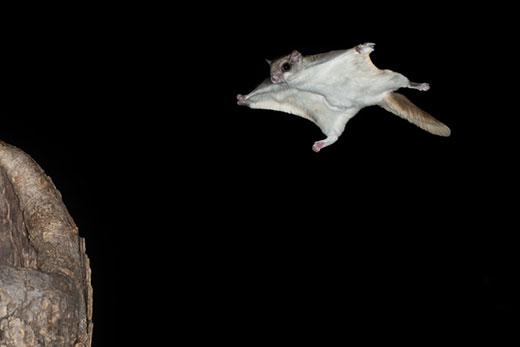
The Southern Flying Squirrel is nocturnal, so many homeowners may not even know the mammal is in their backyard unless they actively look for them.
K-State researchers on the lookout for southern flying squirrel
‘Super cool’ mammal may exist in higher numbers than thought in Kansas
Dec. 14, 2022
By Pat Melgares, K-State Research and Extension news service
MANHATTAN, Kan. – Their name may imply it, but southern flying squirrels don’t actually fly. They only seem to do so.
“They have a specialized membrane (called a patagium) that extends between their front and back feet and allows them to glide from tree to tree,” said Kansas State University wildlife ecologist Adam Ahlers. “They will commonly glide more than 20 feet while using space within their home ranges.”
Ahlers has a hunch that this unique mammal exists in populations much greater than biologists know, and he’s out to find out more. He and a colleague – Andrew Hope, an assistant professor in K-State’s Division of Biology – have launched a three-year project funded by the Kansas Department of Wildlife and Parks to determine how prevalent the southern flying squirrel is in Kansas, and where they are actually found.
Ahlers said while it’s thought the southern flying squirrel will be found in thick forested areas of the state, they may also be found right in homeowner’s backyards.
“They are nocturnal, unlike other squirrels that people see in their yards,” Ahlers said, “so unless someone is actively looking for them at night, there is a good chance you may never see them.”
In urban areas, he adds, southern flying squirrels feed on seed in backyard feeders at night. In all other areas where they’re found, they eat nuts, berries, bird eggs, insects, and are mostly omnivorous. They are the smallest squirrels in North America.
“A really interesting fact about all flying squirrels, discovered just recently, is that they glow hot pink under ultraviolet light,” Ahlers said. “Mammalogists still are not sure why this crazy trait exists in nature.”
Hope said the K-State researchers’ work is particularly important because, in this region, the southern flying squirrel is recognized as a species in need of conservation, a term recognized by biologists as SINC.
“One of the biggest issues with southern flying squirrels, as well as some other SINC species in Kansas, is that we have very little information to determine how healthy the populations are,” Hope said. “A major focus of this project is to gather baseline data to compare these populations with other parts of eastern North America, and from which we can track changes in the future.”
Just as important, Hope notes, is that biologists will also be able to understand how southern flying squirrels are important for other species, wildlife communities and forest health.
“Flying squirrels are cool critters and scientists elsewhere are working with them to answer all sorts of questions, including what they eat, population and community dynamics, genetics, gliding mechanics, and other questions,” Hope said. “But the vast majority of work is occurring further north and further east. Kansas is both drier and warmer than most other areas where flying squirrels occur and as such should provide an important perspective for their biology.”
He adds: “The presence of flying squirrels generally reflects healthy forests. Kansas is famous for its prairies and grasslands, but maybe less well-known for it's hardwood forests. However, forest communities are important through eastern Kansas, and this work will provide more perspective on the role of forest habitats in Kansas.”
Ahlers said southern flying squirrels are “a key part of our state’s biodiversity,” and the three-year project will kelp the Kansas Department of Wildlife and Parks with its conservation efforts for southern flying squirrels.
“I also hope our research will generate interest among Kansans that we have a super-cool mammal in our state, and that they may even exist in our own backyards,” he said.
More information on this project is available online from the Ahlers Wildlife Lab, as well as on Hope’s own website.

